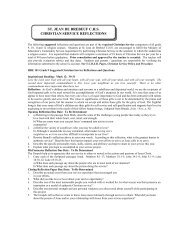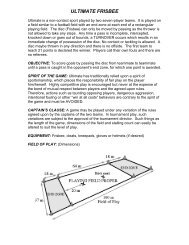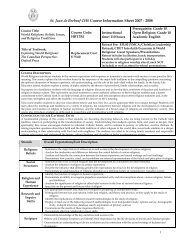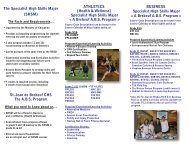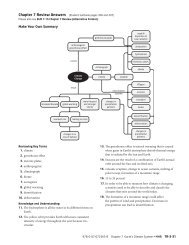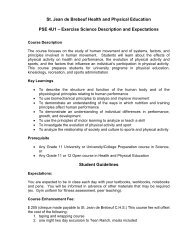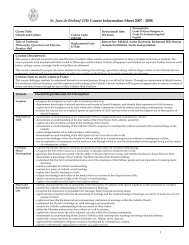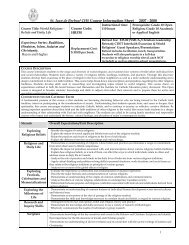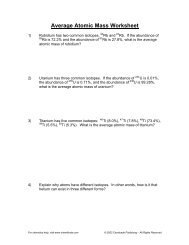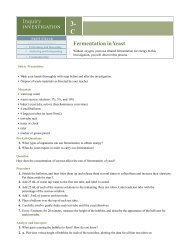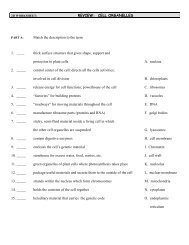Muscular Strength and Endurance[1].pdf
Muscular Strength and Endurance[1].pdf
Muscular Strength and Endurance[1].pdf
You also want an ePaper? Increase the reach of your titles
YUMPU automatically turns print PDFs into web optimized ePapers that Google loves.
<strong>Muscular</strong> <strong>Strength</strong><br />
<strong>Muscular</strong> <strong>Strength</strong> <strong>and</strong> <strong>Endurance</strong><br />
<strong>Muscular</strong> strength is the capacity of your body’s muscles to generate extreme amounts of force in a<br />
short period of time utilizing anaerobic energy. Anaerobic energy provides short term bursts of energy<br />
<strong>and</strong> does not require oxygen. Instead anaerobic energy comes from the burning of carbohydrates <strong>and</strong><br />
can be sustained for a few minutes, after which a short rest time is needed to replenish the system.<br />
Anaerobic energy is used for everything from weight lifting <strong>and</strong> sprinting to the low impact sports of<br />
tennis <strong>and</strong> golf. Anaerobic energy is also used within aerobic-centered workouts when additional spurts<br />
of energy are needed.<br />
Enhanced muscular strength often increases muscle <strong>and</strong> connective tissue size <strong>and</strong> density by enlarging<br />
cells or building muscles. Apart from their aesthetic value, larger muscles <strong>and</strong> connective tissue are les<br />
prone to injury <strong>and</strong> aid long term weight control. Because muscle tissue burns more calories than fat,<br />
even while resting, someone with more muscle will use their stored fat energy on a daily basis.<br />
Tips for Building <strong>Muscular</strong> <strong>Strength</strong><br />
Focus on your exercises. Concentrate on activities that work specific muscle groups <strong>and</strong> use a<br />
program that splits the routine into specific muscles groups each day rather than a full body<br />
workout. Lift weights slowly <strong>and</strong> focus on using the best technique rather than the most weight.<br />
Your workout needs to be efficient first.<br />
Control lactic acid. Anaerobic activity produces lactic acid build-up in muscle, which can lead to<br />
muscle soreness <strong>and</strong> cramping. Doing some light cardio post workout <strong>and</strong> stretching before <strong>and</strong><br />
after workouts can help remove the lactic acid.<br />
Gradual Progression is important. It is more important to get the proper technique first than<br />
look to maximize the weight you can lift. Progression of the stress placed on a muscle is<br />
important for continued gains in muscle strength. Averaging 3 sets of 6 – 8 repetitions is an<br />
excellent way to gain muscle strength, just be sure to increase your weight when you can<br />
perform more than 8 repetitions easily.<br />
Warm-up. A warm-up set or light cardio activity can help prepare the body <strong>and</strong> mind for a more<br />
intense workout without injury.<br />
Rest. With more intense workouts, <strong>and</strong> more damage to the muscles as a result, one or two<br />
days of recovery time is necessary. Allowing the muscle to recover fully will also help prevent<br />
overtraining injuries.
<strong>Muscular</strong> <strong>Endurance</strong><br />
Muscle endurance is the measure of how well muscles can repeatedly generate force, <strong>and</strong> the amount<br />
of time they can maintain activity. <strong>Muscular</strong> endurance is necessary for everyday activities, which<br />
typically involve low impact movements. It is crucial for every fitness activity, from the mostly anaerobic<br />
weight lifting repetitions to the intense aerobic activities like jogging. <strong>Muscular</strong> endurance combines<br />
both aerobic <strong>and</strong> anaerobic energy <strong>and</strong> training for endurance not only involves repeatedly generating<br />
force, but the speed of recovery in a muscle.<br />
Tips for Building <strong>Muscular</strong> <strong>Endurance</strong><br />
Gradual Progression. Like muscular strength, muscle endurance is increased through overload.<br />
Overworking the muscle with a lighter weight but more repetitions is the best way to train for<br />
muscular endurance. Averaging 3 sets of 10 to 15 repetitions is an excellent way to build<br />
endurance. Keep in mind that a spotter should still be necessary for the final 1 or 2 repetitions<br />
to get the most benefit.<br />
Recovery Time. Rest <strong>and</strong> recovery is necessary for your muscle, but decreasing the time<br />
between sets is a way to force the muscle to have faster recovery rate. If more than 12<br />
repetitions are being performed, less than a minute between sets is recommended.
1. Define muscular strength.<br />
<strong>Muscular</strong> <strong>Strength</strong> & <strong>Endurance</strong><br />
2. What type of energy does anaerobic energy provide?<br />
3. List 5 activities that you think would mostly use anaerobic energy.<br />
4. Why does building muscle help maintain weight control.<br />
Name__________________<br />
5. What can stretching <strong>and</strong> light cardio exercise help prevent when done after a workout?<br />
6. List two tips that can help avoid injury.<br />
7. Define muscular endurance.<br />
8. Besides repeatedly generating force, what else contributes to good muscular endurance?<br />
9. What is the main difference between training for strength <strong>and</strong> training for endurance?<br />
10. A grade ten students wants to train for both strength <strong>and</strong> endurance. Is this possible?<br />
Explain why you think this way.


![Muscular Strength and Endurance[1].pdf](https://img.yumpu.com/10485815/1/500x640/muscular-strength-and-endurance1pdf.jpg)


